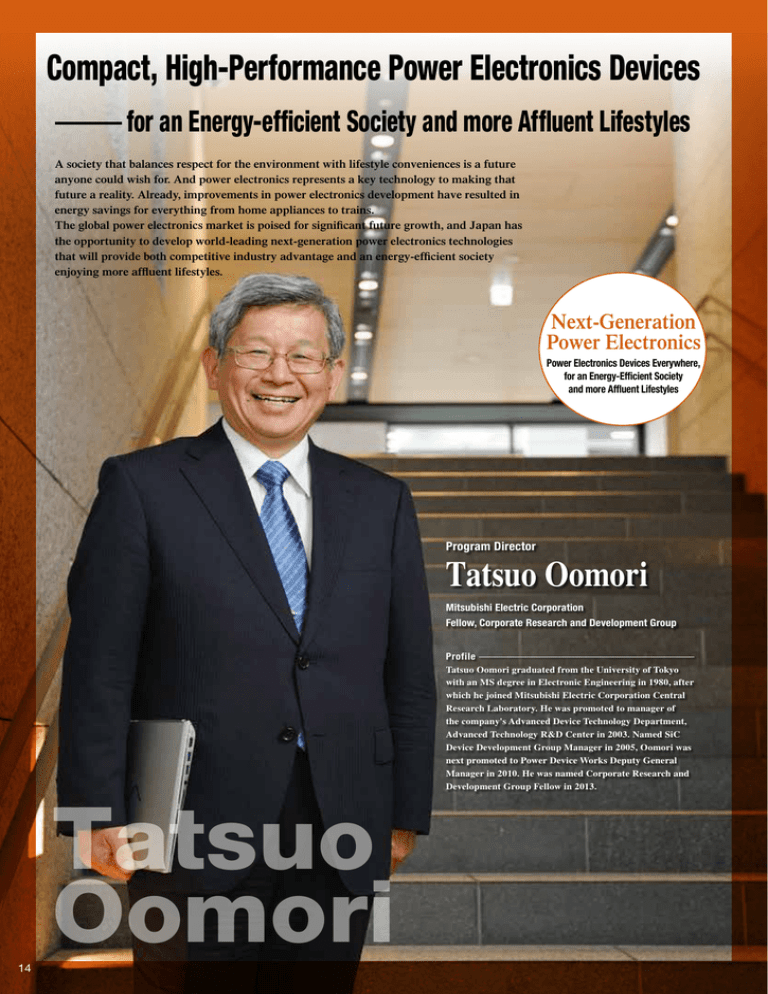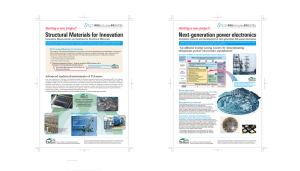Compact, High-Performance Power Electronics Devices Tatsuo
advertisement

Compact, High-Performance Power Electronics Devices for an Energy-efficient Society and more Affluent Lifestyles A society that balances respect for the environment with lifestyle conveniences is a future anyone could wish for. And power electronics represents a key technology to making that future a reality. Already, improvements in power electronics development have resulted in energy savings for everything from home appliances to trains. The global power electronics market is poised for significant future growth, and Japan has the opportunity to develop world-leading next-generation power electronics technologies that will provide both competitive industry advantage and an energy-efficient society enjoying more affluent lifestyles. Next-Generation Power Electronics Power Electronics Devices Everywhere, for an Energy-Efficient Society and more Affluent Lifestyles Program Director Tatsuo Oomori Mitsubishi Electric Corporation Fellow, Corporate Research and Development Group Profile 14 Tatsuo Oomori Tatsuo Oomori graduated from the University of Tokyo with an MS degree in Electronic Engineering in 1980, after which he joined Mitsubishi Electric Corporation Central Research Laboratory. He was promoted to manager of the company's Advanced Device Technology Department, Advanced Technology R&D Center in 2003. Named SiC Device Development Group Manager in 2005, Oomori was next promoted to Power Device Works Deputy General Manager in 2010. He was named Corporate Research and Development Group Fellow in 2013. Power Electronics Devices Everywhere, for an Energy-Efficient Society and more Affluent Lifestyles Power Electronics Supports Energy-Efficient Societies Next-Generation Power Electronics performance of existing materials, developing new materials, and creating technologies that make the most of both,” says Mr. Oomori. At present, SiC is proving to have more advantageous physical properties than Si in practical applications. The plan for this program is to improve SiC in terms of voltage capacity, miniaturization, and reliability, as well as in reducing power loss. To accomplish these goals, the program calls for establishing a research and development network consisting of industry-academy-government resources to strengthen Japan’s capabilities in basic research. Another promising material is gallium nitride (GaN). GaN gained attention recently as a material used in blue lightemitting diodes. This compound is being looked at for use in the power device field, but, unfortunately, GaN wafer quality is not yet at a level suited for practical implementation in power devices. In the U.S. and Europe, GaN-related national projects are already underway. For Japan to take the lead in power electronics technology, the nation must establish an effective industry-academy-government structure for improving the quality of GaN wafers and devices. Consumers can contribute to energy conservation by simply replacing their old air conditioners and refrigerators with newer models. This is a fairly common belief, and the truth is that the latest home appliances use less power than ever. Power electronics technology is the key that makes this progress possible. Power electronics encompasses technologies used for the optimal control of electricity, converting electric currents between DC and AC, while adjusting voltage and frequency. Although this technology is hidden deep inside the products we use, everyone is familiar with the benefits that air conditioners and other appliances provide to make our lives more convenient. Power electronics have been a quiet background player over the past several decades, helping electronics perform better and more efficiently. As the world continues to become more digital, the global market for power electronics is sure to continue to grow rapidly. Japan is currently the leading nation in this field; however, “If Japan is going to keep its place at the top, we have to create even more high-performing power electronics using Developing World-Leading next-generation materials,” says Mr. Tatsuo Oomori, program Fine-Tuned Technologies director of the SIP Next-Generation Power Electronics program. “Even more important is developing fine-tuned technologies,” “We also need to find breakthroughs that will lead to wider says Mr. Oomori. To understand what is meant by fine-tuned, usage and greater adoption.” imagine a radio with several dials. You change the frequency Silicon carbide (SiC) and gallium nitride (GaN) are two of the radio by turning a dial to hear more clearly. You can also new compounds that are replacing silicon in electronics. adjust the volume with another dial to hear better. It’s a balance Here, however, the United States and Europe have the upper of frequency and volume. So, in one device you have two hand in next-generation materials development, while the completely different ways to adjust for better hearing. “Just like nations of Asia are working feverishly to catch up. The that radio, fine-tuned technologies offer different ways to draw goal of the Next-Generation Power Electronics program is out 100 percent of the performance capabilities of a device,” to develop common fundamental technologies that focus on next-generation materials for better performance, wider applications, and greater Evaluation and adoption. In so doing, we believe we can Verification Identify Issues Basic Research make a grand lea forward in power savings Module Development Industry-AcademyResearch of Phenomena Government Implementation and bolster the competitive posture of Cooperative Structure Research of Mechanisms Propose Verifications Technology Japan’s industries at the same time. Developing New Materials Technologies to Replace Silicon Power electronics devices are used in everything from home appliances to elevators, trains to hybrid cars, and virtually everything in between. Power electronics plays a role in anything that uses electricity, and it is expected that the range of uses and applications will continue to expand in the future. “We hope to put next-generation power electronics into practical use as quickly as possible. We believe that we can make life better by improving the Device Supply, Test Products Evaluation and Verification Identify Issues Basic Research Research of Phenomena Research of Mechanisms Propose Verifications Device Development Industry-AcademyGovernment Cooperative Structure of Principles Evaluation and Verification Identify Issues Wafer Test Item/Test Basic Research Research of Phenomena Research of Mechanisms Propose Verifications Wafer Development Establish Network of Principles Industry-AcademyGovernment Cooperative Structure of Principles •Conceptual diagram of the organization for the SiC common basic technology development Cross-ministerial Strategic Innovation Promotion Program (SIP) 15 Tatsuo Oomori Cabinet Office PD (Tatsuo Oomori) Sub-PD (Professor Hori, University of Tokyo) Promoting Committee Members: PD, outside experts, Ministry of Economy, Trade and Industry, Ministry of Education, Culture, Sports, Science and Technology, Ministry of Internal Affairs and Communications, Ministry of Defense, NEDO, JST, Cabinet Office NEDO Intellectual Property Committee SiC SiC SiC Modules Wafers Devices Modules for HV Research and Development Items Ⅰ GaN Wafers GaN Devices Leadership Council GaN Basic Technologies Research and Development Items Ⅱ Power Electronics Device Integrated System Workshop Electromechanically Integrated Inverter Research and Development Items Ⅲ Foundation for New Materials New Circuits/ Software New Processes/ Evaluation Techniques for HV Research and Development Items Ⅳ •Implementation Structure says Oomori. “Developing delicate technologies for fine-tuning is something that the Japanese excel at.” This project has brought together nine universities and two private companies to develop circuitry technologies and system implementation technologies for high-efficiency, highperformance electricity conversion systems. These systems will lead to advancements in the fine-tuning of devices that use new materials and an expanded range of uses for next-generation power devices. This project is looking even further into the future toward pioneering materials that will replace SiC and GaN. Top Japanese researchers in diamonds and gallium(III) oxide (Ga2O3) have been brought in to create wafers, devices, and modules featuring new structures. These experts are also assigned to conduct basic research believed to lead to revolutionary performance gains. At the same time, other projects under this program call for developing control circuitry and software integration for greater performance gains. Another goal of this program is to invest resources into developing evaluation techniques and in the training and education of next-generation scientists and engineers who will be making important contributions in this field in the future. A Stronger Industry for a Healthier, Happier Society How much energy savings could we expect, if the next-generation power devices developed by this program replaced the power devices in use in Japan today? Mr. Oomori says, “While the energy savings for a single home appliance may be small, we can expect an enormous cumulative 16 Cross-ministerial Strategic Innovation Promotion Program (SIP) gain. At a rough estimate, we believe there could be a savings equal to the overall volume of electricity used in Tokyo today.” Developing devices that perform at higher levels with lower cost could result in greater adoption among rail transportation, automobiles, and other applications that demand large amounts of electricity. Further into the future, we may see a time when these technologies are used to control electricity transmission for renewable energies. The wider the adoption of next-generation power electronics, the greater the energy savings benefits that will naturally follow. How would this affect society 20, 30, or 40 years down the road? And what expectations do our citizens have for their ideal society of the future? At present, Mr. Oomori is conducting interviews with experts in Japan and around the world to develop a picture of the ideal future. Once this picture is clear, Oomori intends to draft a roadmap to guide next-generation power electronics. “What kind of technologies, devices, and performance do we need to create the future society that people want?” asks Oomori. “I believe we can make Japanese industry stronger by creating a development strategy that backcasts from this future vision.” A successful Next-Generation Power Electronics program could re-energize Japan and make life better for its citizens by strengthening the competitive posture of Japan’s electrical and materials manufacturers. Ideally, the results of this program will create technology that leads to a society that balances the needs of the environment with the needs for convenient, comfortable lifestyles. Mr. Oomori’s dream is to help create this kind of society, developing power electronics technologies that increase performance and energy efficiency for all electronic devices. Power Electronics Devices Everywhere, for an Energy-Efficient Society and more Affluent Lifestyles Next-Generation Power Electronics Research and Development Topics 1. Create a center for common basic technology development related to SiC To bolster basic technologies for silicon carbide (SiC) power electronics, the program will construct a network of industryacademy-government experts, directed by a research institution. The program will use a research and development center to facilitate efficient research and development for improving the performance, functionality, and voltage capacity of SiC wafers, devices and modules. At the same time, this organization will be responsible for training and educating younger researchers. 2. Create a center for common basic technology development related to GaN To bolster basic technologies for gallium nitride (GaN) power electronics, the program will construct a network of industry-academy-government experts, forming a research center. The center will develop innovative GaN wafer technologies and vertical GaN power device process technologies. 3. Conduct basic research and development for next-generation power module application To promote the adoption of next-generation power electronics technologies, the program will develop fine-tuned technologies for circuits and controllers to derive maximum performance from power electronics. The program will offer high-value-added results through applied technologies and systems technologies development. 4. Conduct basic research and development to support future power electronics To produce high-performance power devices that exceed the performance available through SiC and GaN, the program will pioneer new technologies using gallium(III) oxide (Ga₂O₃) and diamonds, while at the same time conducting research that leads to revolutionary performance improvements in the development of new structures and new circuits. Exit Strategies Consider and formulate strategy Consider and formulate a strategy for activities toward creating an ideal society, as well as for finding new applications and implementation of technologies. Create new industries and markets based on power electronics. Prove required performance levels through prototyping Prove performance, quality, and manufacturability using prototypes to demonstrate successful development of technologies that meet performance and specification requirements identified via backcasting. Promote the development of product commercialization in industry. Engage in activities to promote adoption of results Conduct standardization and other activities to promote the adoption of program results. Research the best standardized test methods for assessing the performance of component parts to promote standardization. Promote research of a performance certification system for each component and material. Our goal is to produce major advances in energy-saving and high-performance technologies for electrical products used around the world, leading to stronger Japanese industries and more highly trained human resources. Develop and standardize power electronics that lead to our ideal future society 17





